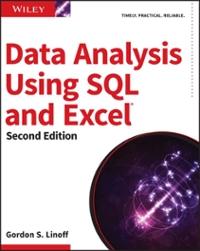Question
In c++ Section 1. Stack ADT Overview Data Items The data items in a stack are of generic DataType. This means use should use templating
In c++
Section 1. Stack ADT Overview
Data Items
The data items in a stack are of generic DataType. This means use should use templating and your Node class.
Structure
The stack data items are linearly ordered from the most recently added (the top) to the least recently added (the bottom). This is a LIFO scheme. Data items are inserted onto (pushed) and removed from (popped) the top of the stack.
Operations
Constructor. Creates an empty stack.
Copy constructor. Initializes the stack to be equivalent to the other Stack object parameter.
Overloaded assignment operator. Sets the stack to be equivalent to the other Stack object parameter and returns a reference to the modified stack.
Destructor. Deallocates the memory used to store the stack.
push (const DataType& newDataItem)
Requirements: Stack is not full.
Results: Inserts newDataItem onto the top of the stack.
DataType peek()
Requirements: Stack is not empty
Results: returns a copy of the value of the most recently added (top) data item from the stack
void pop()
Requirements: Stack is not empty
Results: Removes the most recently added (top) data item from the stack.
void clear()
Requirements: None
Results: Removes all the data items in the stack.
bool isEmpty() const
Requirements: None
Results: Returns true if the stack is empty. Otherwise, returns false.
bool isFull () const
Requirements: None
Results: Returns true if the stack is full. Otherwise, returns false.
Section 2. Implementation Approaches
As in the class, we consider both
Array-based implementations
Linked-List implementations
For this assignment, create the link-based implementation!
Section 3.
Programming Exercise 1
We commonly write arithmetic expressions in the so-called infix form. That is, with each
operator placed between its operand, as below
(5+6)*(4/3)
Although we are comfortable writing expressions in this form, infix form has the
disadvantage that parentheses must be used to indicate the order in which operators
are to be evaluated. These parentheses, in turn, complicate the evaluation process.
Evaluation is much easier if we can simply evaluate operators from left to right.
Unfortunately, this evaluation will not work with the infix form of arithmetic expressions.
However, it will work if the expression is in postfix form. In the postfix form of an arithmetic
expression, each operator is placed immediately after its operands. The expression
above is written in postfix form as
56+43/*
Note that both forms place the numbers in the same order (reading from left to right).
The order of the operators is different, however, because the operators in the postfix form
are positioned in the order that they are evaluated. The resulting postfix expression is hard
to read at first, but it is easy to evaluate programmatically. We will do so with stacks.
Suppose you have an arithmetic expression in postfix form that consists of a sequence of
single digit, nonnegative integers and the four basic arithmetic operators (+,-,*,/). This
expression can be evaluated using the following algorithm in conjuction with a stack of
floating-point numbers.
Read the expression character-by-character. As each character is read in:
If the character corresponds to a single digit number (characters 0 to 9), then
push the corresponding floating-point number onto the stack.
If the character corresponds to one of the arithmetic operators (characters +, -
, *, /), then
Pop a number off of the stack. Call it operand1.
Pop a number off of the stack. Call it operand 2.
Combine these operands using the arithmetic operator, as follows
Result = operand2 operator operand1
Push result onto the stack.
When the end of the expression is reached, pop the remaining number off the stack. This
number is the value of the expression. Applying this algorithm to the arithmetic expression
34+52/*
Results 17.5 as expected.
Create a program that reads the infix form of an arithmetic expression, evaluates it, outputs the postfix expression, and outputs the result. Assume that the expression consists of single-digit, nonnegative integers (0 to 9) and the FIVE basic arithmetic operators (+,-,*,/,^) (note to correctly handle ^). Further assume that the arithmetic expression is input from the keyboard with all the characters separated by white space on one line. Save your program in a file called postfix.cpp
Step by Step Solution
There are 3 Steps involved in it
Step: 1

Get Instant Access to Expert-Tailored Solutions
See step-by-step solutions with expert insights and AI powered tools for academic success
Step: 2

Step: 3

Ace Your Homework with AI
Get the answers you need in no time with our AI-driven, step-by-step assistance
Get Started


